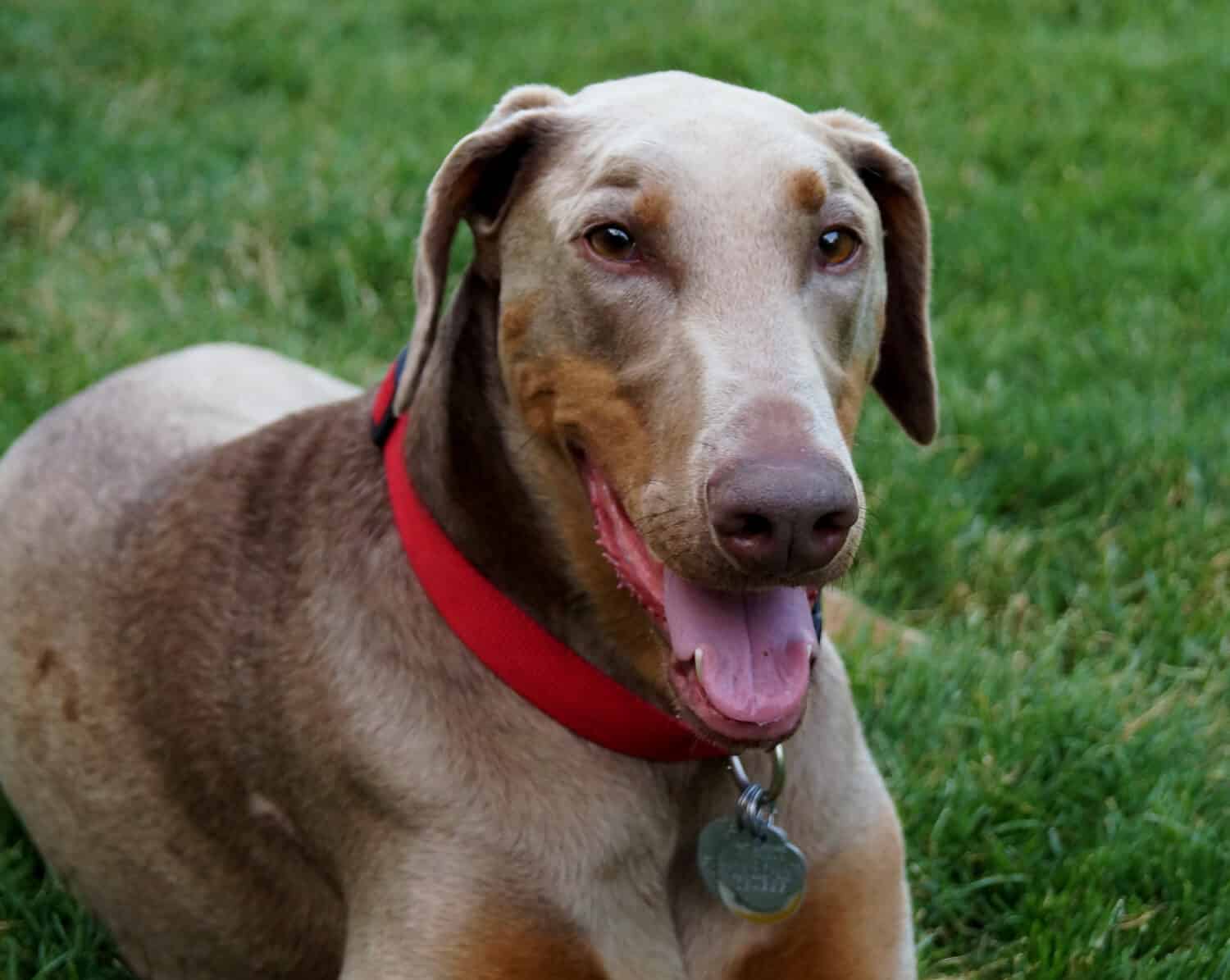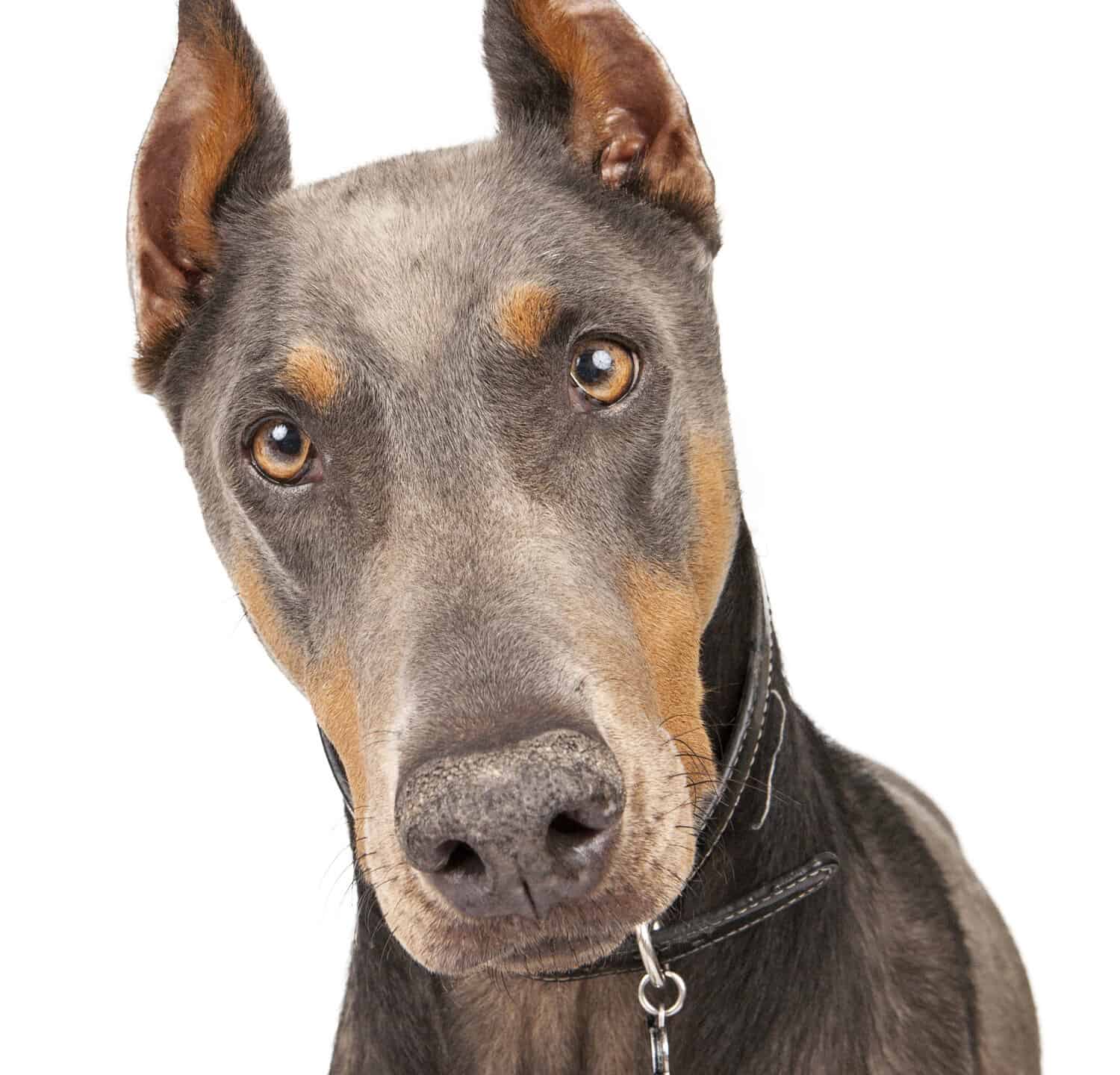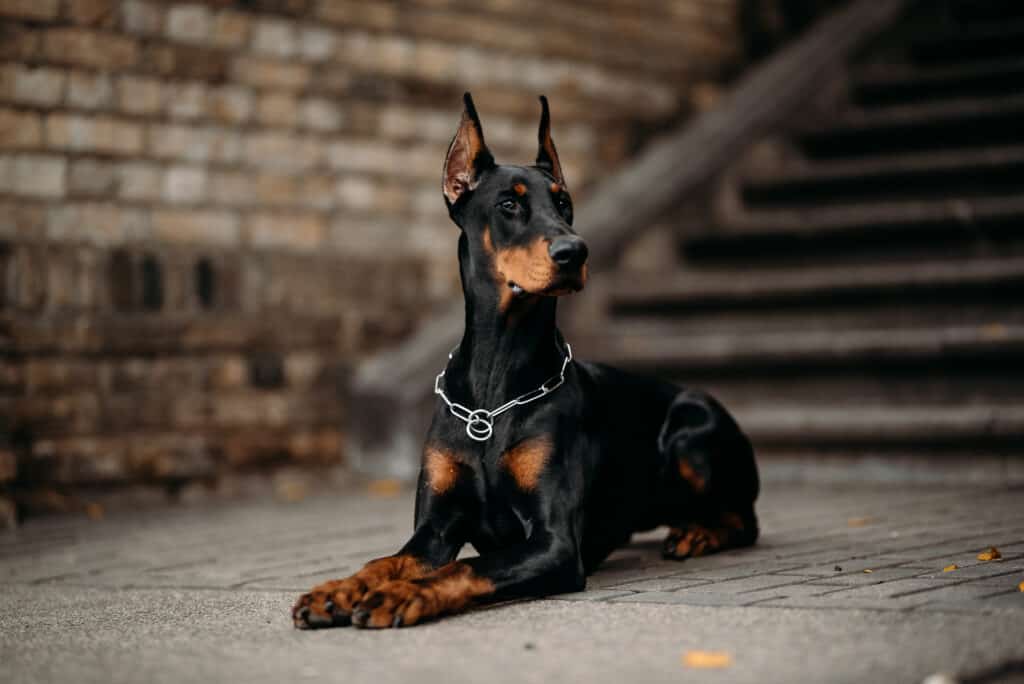Bred in Germany as guard dogs during the late 19th century, the Doberman Pinscher is believed to be a mixture of many dog breeds, including German Pinscher, Rottweiler, and Black and Tan Terrier. These smart and energetic dogs have sleek coats, regal appearances, and athletic builds. Furthermore, they are very good family companions, and they excel in canine sports and police and military work. Doberman Pinschers come in various colors, but the American Kennel Club (AKC) only recognizes five colors, including the rare White Doberman Pinscher. The other recognized colors include red and rust, fawn and rust, blue and rust, and black and rust.
White Doberman
The most unique and rarest Doberman is the white Doberman. These dogs come in a pure solid white or a cream-white color. Unfortunately, there are health problems associated with these Dobermans. These white Dobermans are albino or partial albino. White Dobermans are relatively new. The first known case occurred in 1976 when a dog named Sheba was born. They may look very cool and unique, but they tend to have multiple health and behavioral issues.
Fawn Doberman
The next rarest Doberman Pinscher is the fawn Doberman. These dogs may also have health issues. Fawn Dobermans are exotic and unique, and unfortunately, some breeders will attempt to breed for these dogs to sell for big profits with no concern for the dog. Furthermore, they are even more uncommon than blue Doberman Pinschers.

One of the rarest Doberman Pinschers is the fawn Doberman.
Image: Just_Julie, Shutterstock
©Just_Julie/Shutterstock.com
Fawn and Rust Doberman
Not many people have heard about fawn and rust Dobermans, but the AKC recognizes this color. Fawn and rust Dobermans, like the blue Dobermans, carry the recessive dilute gene, which leads to their unique coloring. However, instead of having the gene for a black coat, these fawn and rust Dobermans have the gene for a red coat. Therefore, the fawn color is a result of manipulating the red coat. Their coat colors look brown with a much less reddish undertone, almost like a light milk chocolate color. The rust and the fawn are very similar, and it might be hard to see, but these dogs have tan markings around their muzzle, legs, ears, chest, legs, bottom, eyebrows, and under their tail.
Red Doberman
Another rare Doberman Pinscher color is red; like the other solid colors, they are uncommon. They are also unethical to breed as they may have health problems similar to the other melanistic Doberman Pinschers. Some might consider the red and rust with light markings a red Doberman. However, they are sometimes called chocolate Dobermans.

Another rare Doberman Pinscher color is red.
Image: Kristina Chizhmar, Shutterstock
©Kristina Chizhmar/Shutterstock.com
Blue Doberman
The solid blue Doberman Pinscher might be even more uncommon than the black Doberman Pinscher. They are also unethical to breed as they may have many health problems. However, some might not have any health issues. Like other dog breeds known as blue, these dogs are actually grey or silver. These dogs are susceptible to several health conditions, including Color Dilution Alopecia, Cardiomyopathy, and Von Willebrand Disease. As with most dog breeds with a blue variation, such as the French Bulldog, it is quite common for them to have Color Dilution Alopecia, leading to severe hair loss that can cause skin infections.

The solid blue Doberman Pinscher might be even more uncommon than the black Doberman Pinscher.
Image: GoodFocused, Shutterstock
©GoodFocused/Shutterstock.com
Blue and Rust Doberman
These Doberman Pinschers are a sight to behold. They are not as common as the black and rust variety but very popular. Sometimes they are also called the gray Doberman. Furthermore, they are “blue” because they have inherited copies of the dilute recessive gene and also have black and rust Dobermans genes.
Solid Black Doberman
As with many of the other Doberman Pinschers, the solid black variety is unethical, as breeding these dogs can result in many health issues. They are very rare and are sometimes called melanistic Dobermans. Also, they are not recognized by the AKC. In addition, they have no other color markings and are quite sought after, even though breeders are aware of their health risks.

As with many of the other Doberman Pinschers, the solid black variety is unethical, as breeding these dogs can result in many health issues.
Image: Soydaner Gundogdu, Shutterstock
©Soydaner Gundogdu/Shutterstock.com
Red and Rust Doberman
The second most popular color of Doberman Pinschers is red and rust. Some people prefer them to the traditional black and rust Dobermans. They appear reddish-brown and are also called red Dobermans. However, some people call them brown Dobes. Also, they have tan markings on their chest, eyebrows, muzzle, legs, and under their tail.
Black and Rust Doberman
The most common color of Dobermans is black and rust. These are the Doberman Pinschers you see the most and what many people think of when they imagine a Doberman Pinscher. In addition, they are the ones used in movies, comic books, and films. Some people call them black and brown Dobermans or black and tan Dobermans. These dogs have sleek black coats with tan markings on their eyebrows, legs, muzzle, chest, ears, and under their tails. Lastly, they are the easiest to come by and one of the colors recognized by the AKC.

The most common color of Dobermans is black and rust.
©JELIZAVETA KARAKAJA/Shutterstock.com
History
In the 19th century in Germany, there was a tax collector named Louis Doberman. As a tax collector, he was always worried about bandits attacking him. However, he was also the town’s animal control officer and started taking dogs on his rounds to protect him. Later he started breeding with dogs and was looking for a loyal companion as well as a protector. This led to the early Doberman Pinscher. He allegedly bred the German Pinscher, black and tan terrier, and Rottweiler.
The first known Doberman Pinscher was seen in 1876 and was met with great eagerness. After Doberman passed, German breeders continued his work and concentrated on function rather than appearance. However, the breed became known as aggressive and headstrong. Furthermore, a breeder by the name of Otto Goeller was successful in breeding a more usable dog, and in 1900 the German Kennel Club recognized the Doberman Pinscher as a breed.
Personality
These dogs are very active and highly intelligent. Doberman Pinschers are also loyal, fun-loving, and trustworthy. Furthermore, they are natural protectors and won’t hesitate to attack when threatened, but they won’t just attack for no reason. They like to be active, and training is easy as they learn quickly. Also, they may take some time to grow up and only really mature at about 3 or 4 years old. Many things can affect their temperaments, such as training, heredity, and socialization. Therefore, early socialization and exposure to many things, sights, and smells are critical.
Health
Most Doberman Pinschers are generally healthy dogs, but they can develop some of the following conditions:
- Hypothyroidism: a disorder of the thyroid gland. It may lead to obesity, epilepsy, hair loss, and skin conditions. It is treatable with diet and medication.
- Von Willebrand’s Disease: an inherited disease where the blood does not clot. This could result in bleeding gums, nose bleeds, and bleeding in the intestines or stomach. The only treatment is a blood transfusion. However, dogs with this condition can lead a normal life.
- Albinoism is a genetic condition where it is not just a white dog but has pink skin and a pink nose with blue or light eyes. These dogs can suffer from many health issues, including eye problems and cancer.
- Progressive Retinal Atrophy (PRA): a family of eye diseases involving progressive retina deterioration. These dogs will become night-blind before losing their sight altogether.
- Wobbler’s Syndrome: this disease is suspected to be inherited. Dogs suffer from spinal cord compression that is caused by cervical vertebral instability or a malformed spinal canal. Some dogs with this condition suffer from paralysis of the legs or neck pain. Surgery is the recommended treatment.
- Hip dysplasia: a condition where the thighbone does not fit properly in the hip joint. This is an inherited condition. It can cause pain and lameness.
- Cardiomyopathy: this disease results in a weak and thin heart muscle resulting in an abnormally large heart. Furthermore, the heart cannot efficiently pump blood to the rest of the body, and it can result in heart failure. Treatment includes fluid therapy, oxygen, and medication.
- Color mutant alopecia: many blue Doberman Pinschers suffer from this disease. Its symptoms include hair loss and brittle hair, leading to inflammation and infection. It is an incurable but manageable disease.
- Gastric dilatation-volvulus: Also called bloat, this issue can affect large, deep-chested dogs like Doberman Pinschers. The stomach gets distended with gas or air and twists. The dog cannot vomit or rid themselves of the gas, and their blood pressure drops, leading to shock. It is a life-threatening condition.
Summary of Doberman Pinscher Colors: Rarest to Most Common
| Number | Doberman Color |
|---|---|
| 1 | White |
| 2 | Fawn |
| 3 | Fawn and Rust |
| 4 | Red |
| 5 | Blue |
| 6 | Blue and Rust |
| 7 | Solid Black |
| 8 | Red and Rust |
| 9 | Black and Rust |
Ready to discover the top 10 cutest dog breeds in the entire world?
How about the fastest dogs, the largest dogs and those that are -- quite frankly -- just the kindest dogs on the planet? Each day, AZ Animals sends out lists just like this to our thousands of email subscribers. And the best part? It's FREE. Join today by entering your email below.
Thank you for reading! Have some feedback for us? Contact the AZ Animals editorial team.







